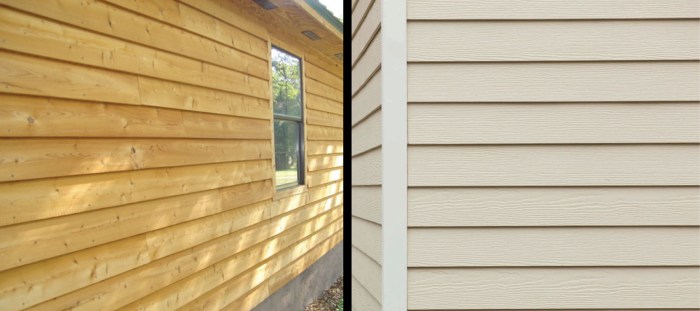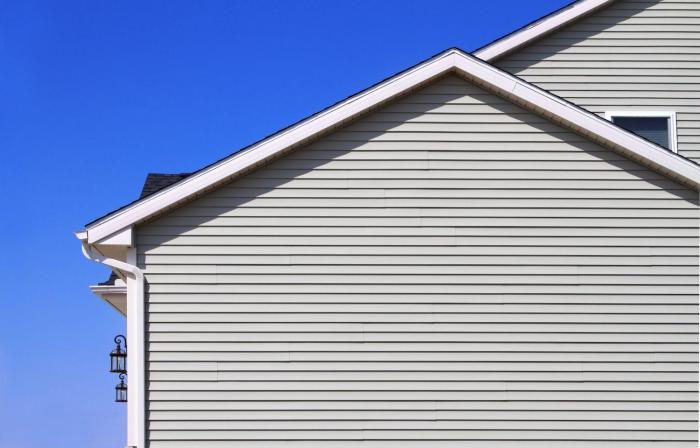Wood Siding vs Vinyl Siding: A Comprehensive Comparison

Exploring the differences between wood siding and vinyl siding, this introduction sets the stage for a detailed analysis of these popular home construction materials. From durability to aesthetics, we delve into every aspect to help you make an informed decision for your home.
Whether you're considering a rustic charm with wood siding or a modern appeal with vinyl, this discussion covers all the key points to guide you through the decision-making process.
Introduction

Wood siding and vinyl siding are two popular choices for exterior cladding in home construction. Wood siding is made from natural wood materials such as cedar or pine, while vinyl siding is a synthetic material composed of PVC (polyvinyl chloride).
Both types of siding have their own unique characteristics and benefits that appeal to homeowners.Wood siding has a timeless and classic look that adds warmth and charm to a house. It is known for its natural beauty, versatility, and ability to be painted or stained in various colors.
On the other hand, vinyl siding is low-maintenance, durable, and comes in a wide range of colors and styles. It is also resistant to rot, insects, and moisture, making it a practical choice for many homeowners.The choice of siding plays a significant role in enhancing the exterior aesthetics of a house.
It not only protects the structure from the elements but also adds curb appeal and value to the property. The color, texture, and style of siding can greatly impact the overall look and feel of a home, making it an important design element in home construction and renovation projects.
Durability Comparison
Wood siding and vinyl siding have different levels of durability when it comes to withstanding various weather conditions and maintenance requirements.
Weather Resistance
Wood siding is susceptible to rot, mold, and insect damage when exposed to moisture over time. In contrast, vinyl siding is more resistant to moisture and does not rot or warp, making it a better option for humid or wet climates.
Maintenance Requirements
Wood siding requires regular maintenance such as painting, staining, and sealing to protect it from the elements and maintain its appearance. On the other hand, vinyl siding is low maintenance and only requires occasional cleaning with soap and water to keep it looking new.
Cost Analysis
When comparing wood siding versus vinyl siding, one of the key factors to consider is the cost associated with each option. Let's delve into the cost analysis of these two popular siding materials.
Initial Installation Costs
- Wood siding typically has a higher initial installation cost compared to vinyl siding. The price of wood siding can vary depending on the type of wood chosen, with cedar and redwood being more expensive options.
- Vinyl siding, on the other hand, is generally more budget-friendly and cost-effective for homeowners looking to save on upfront expenses.
- Additional factors that can impact initial installation costs include the size of the property, labor costs in the area, and any preparation work needed before siding installation.
Long-Term Maintenance Expenses
- Wood siding requires more maintenance over time compared to vinyl siding. This includes regular painting, staining, and sealing to protect the wood from moisture, pests, and other elements.
- Vinyl siding, on the contrary, is low-maintenance and does not require painting or staining. Cleaning with soap and water is usually sufficient to keep vinyl siding looking fresh.
- While the initial cost of wood siding may be higher, the long-term maintenance expenses can add up, making it a more costly option in the long run compared to vinyl siding.
Cost-Effectiveness Factors
- The cost-effectiveness of wood siding versus vinyl siding can vary based on factors such as the climate in which the property is located. Wood siding may require more maintenance in humid or wet climates, increasing long-term costs.
- Additionally, the location of the property can impact material costs, labor costs, and availability of skilled professionals for installation, which can influence the overall cost of siding.
- Homeowners should consider these factors along with their budget and aesthetic preferences when deciding between wood siding and vinyl siding for their homes.
Aesthetics and Design
Wood siding and vinyl siding offer different aesthetic appeal and design options that can complement various architectural styles.
Aesthetic Appeal
Wood siding is known for its timeless and natural look, providing a warm and inviting appearance to a home. The texture and grain of wood give a unique character that many homeowners find appealing. On the other hand, vinyl siding comes in a wide range of colors and finishes, offering a more versatile and customizable look.
While it may not have the same natural appeal as wood, vinyl siding can mimic the look of wood or achieve a modern aesthetic.
Design Options
Wood siding comes in various styles such as clapboard, shingles, and board and batten, allowing homeowners to choose the one that best suits their preferences and architectural style. Additionally, wood siding can be painted or stained in different colors to match the overall design of the home.
Vinyl siding also offers a variety of options, including horizontal and vertical panels, shakes, scallops, and more. It can be found in an extensive range of colors and textures to suit different design preferences.
Complementing Architectural Styles
Wood siding is often associated with traditional and rustic architectural styles, adding a classic and charming touch to a home. It can beautifully complement Victorian, Colonial, Craftsman, and Cottage-style homes. On the other hand, vinyl siding is versatile and can complement a wide range of architectural styles, including modern, contemporary, and even traditional homes.
With its customizable options, vinyl siding can adapt to different design aesthetics and preferences.
Environmental Impact

When considering the environmental impact of wood siding versus vinyl siding, it is essential to look at various factors that contribute to sustainability and eco-friendliness.
Material Sustainability
Wood siding is considered a more sustainable option compared to vinyl siding. Wood is a renewable resource that can be sourced from responsibly managed forests, promoting forest health and biodiversity. On the other hand, vinyl siding is made from PVC, a type of plastic derived from fossil fuels, which is not renewable and has a significant environmental impact during its production.
Production Process
The production of wood siding typically requires less energy compared to vinyl siding, which involves the use of fossil fuels in the manufacturing of PVC. Additionally, the chemical processes involved in producing vinyl siding can release harmful toxins into the environment, contributing to pollution and environmental degradation.
Disposal and Decomposition
When it comes to disposal, wood siding is biodegradable and can decompose naturally over time, minimizing its impact on landfills. In contrast, vinyl siding is not biodegradable and can release toxic chemicals when incinerated, posing environmental risks. Proper disposal of vinyl siding is crucial to prevent harmful environmental consequences.
Closing Notes
In conclusion, the debate between wood siding and vinyl siding offers a myriad of factors to consider. From cost and durability to environmental impact, each material has its strengths and weaknesses. Ultimately, the choice between the two comes down to personal preference and specific home requirements.
FAQ
Is wood siding more expensive than vinyl siding?
While wood siding may have a higher initial cost, vinyl siding tends to have lower long-term maintenance expenses, making it a more cost-effective choice in the long run.
Which siding is more environmentally friendly, wood, or vinyl?
Wood siding is considered more environmentally friendly as it is a natural material and biodegradable. However, vinyl siding has lower energy consumption during manufacturing and transportation.
Can vinyl siding mimic the look of real wood effectively?
Yes, advancements in manufacturing technology have allowed vinyl siding to closely mimic the appearance of real wood, offering homeowners a cost-effective alternative with a similar aesthetic.




